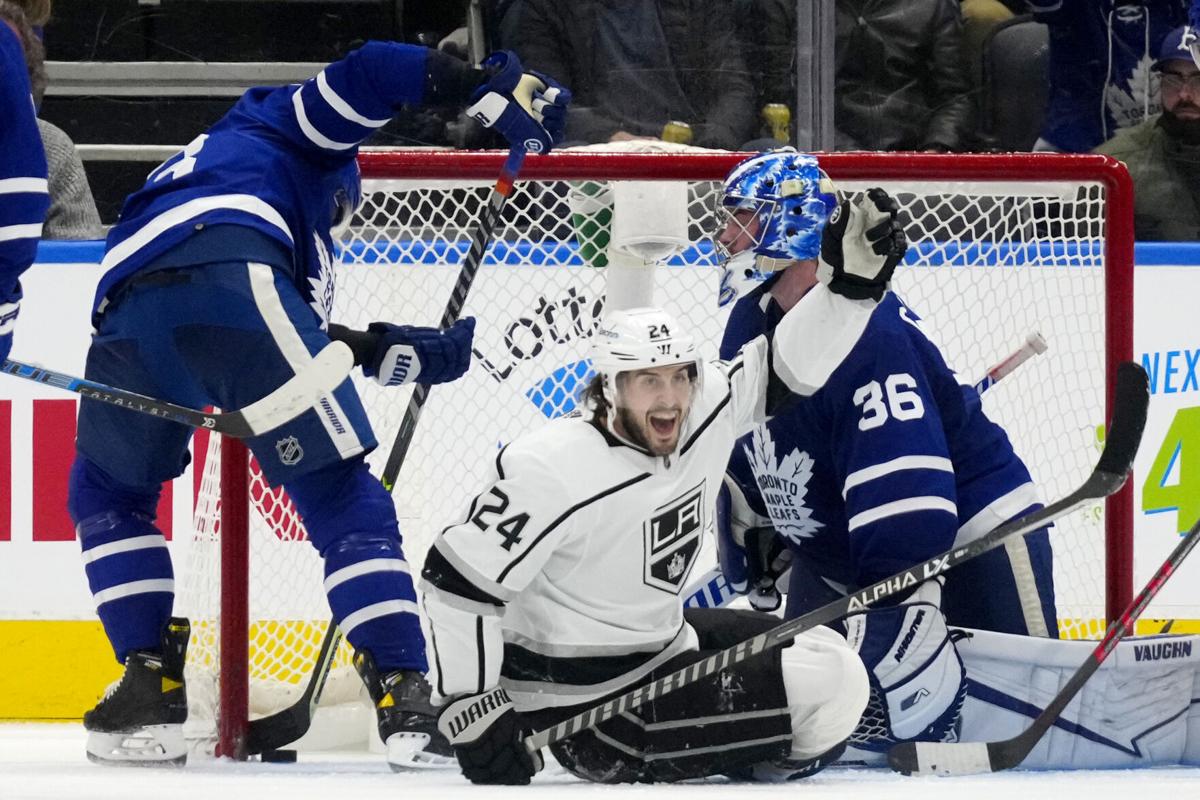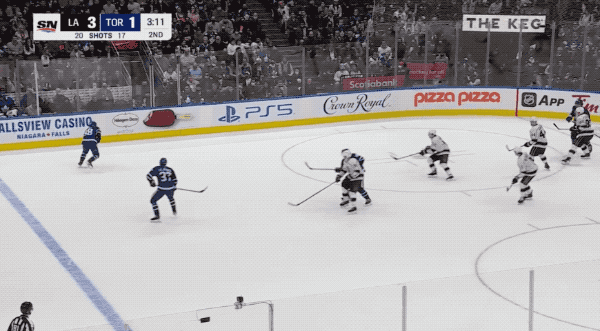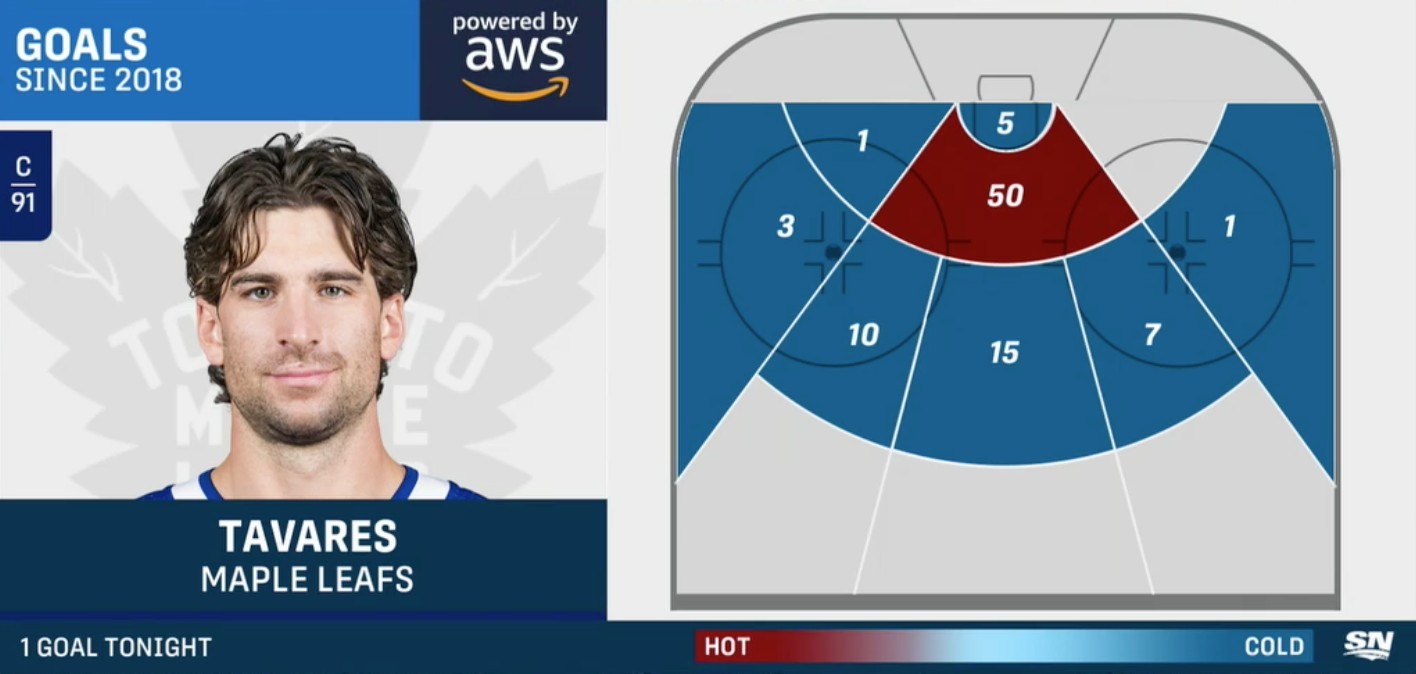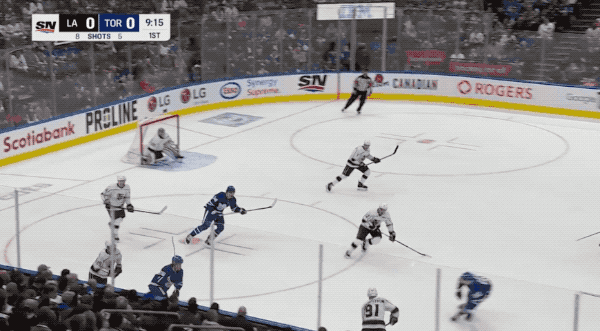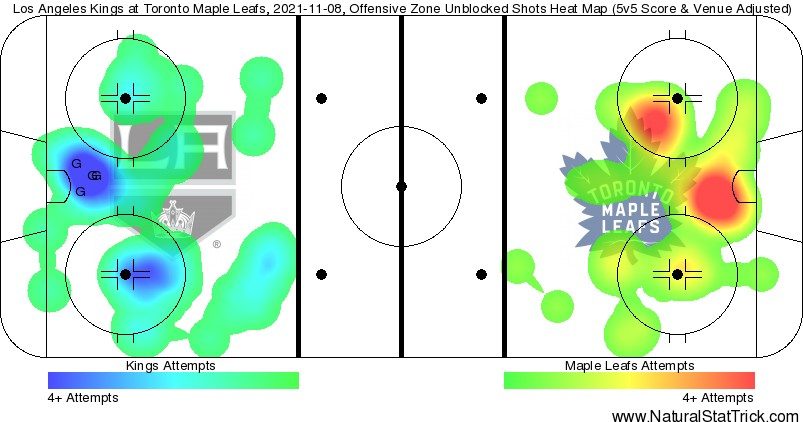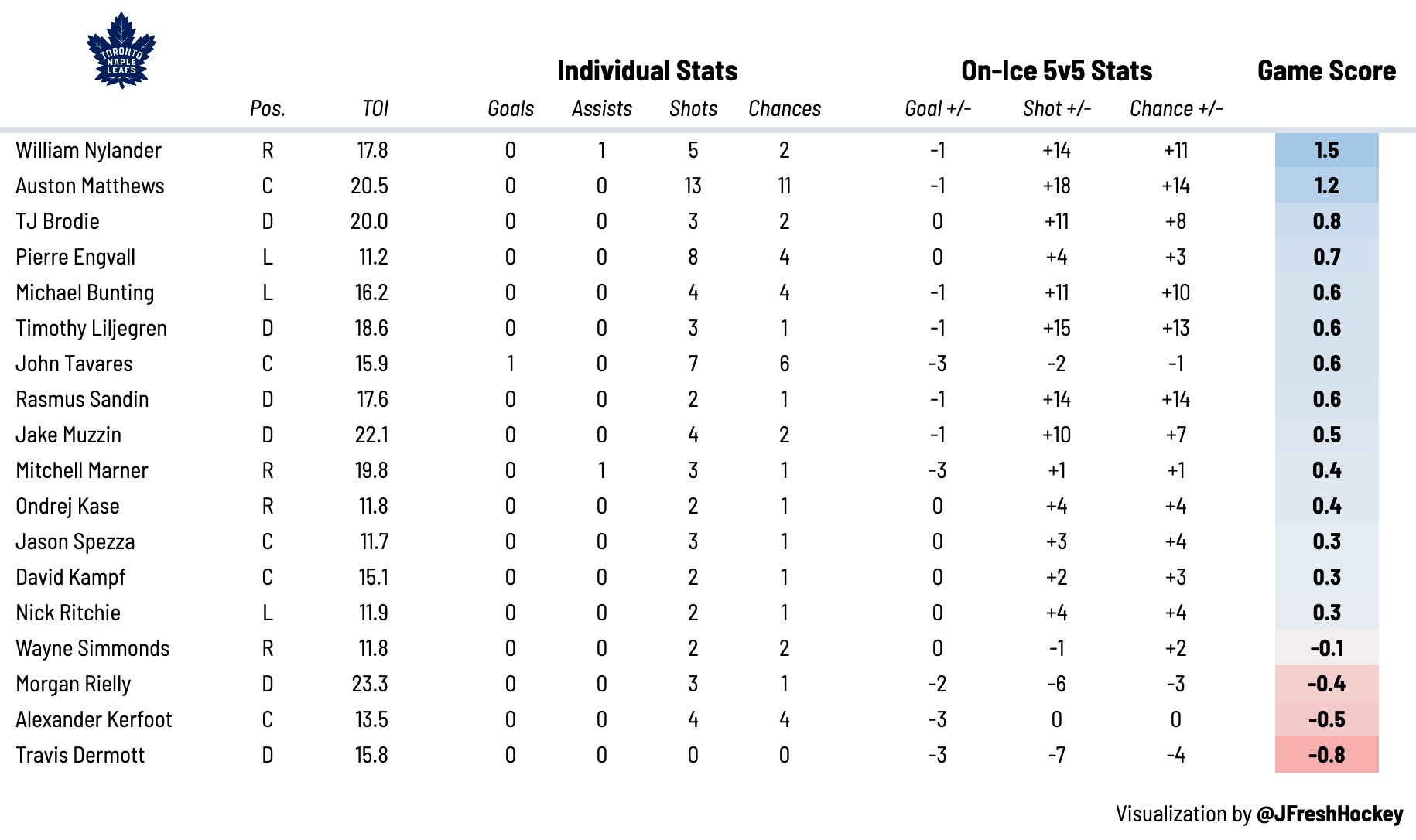Let’s dispel some myths real quick.
Whenever you see a final score of 5-1, your assumption is that the losing team got their teeth kicked in — that wasn’t the case tonight. Toronto actually had the majority of the shots and scoring chances in this game. They just needed a few extra saves. A goal or two might have helped, too.
In typical Leafs fashion, they allowed an early goal to former-Leaf Trevor Moore, while Philip Danault haunted Toronto in their own building once again. Some things never change.
I’ll try my best to not doom-and-gloom over a loss where the Leafs actually outplayed their opponent, although there are some major criticisms to take out of tonight’s performance, particularly concerning the team’s first period. We’ll get to those at the end, starting as always with the best players this evening.
It’s time for some Leafs Report Cards!
4 Stars
Auston Matthews (C, #34) — Sometimes I just laugh looking up the box scores for Auston Matthews. He had 13 shot attempts in this game, 11 of them coming from the slot. That’s absurd. What’s even more absurd is that none of them crossed the goal line, but hey, sometimes that happens in this sport.
He also made a couple of great passes tonight, most notably a stretch pass up to Nylander-Bunting for a 2-on-1. What really stood out to me, though, was Matthews’ speed off the rush. This is the fastest I can remember him looking throughout his career; he’s blowing by his man in the neutral zone and it’s leading to some really good rush chances.
He’s listed at 205 pounds at HockeyDB, which is way down from where he used to be. We’ve seen star players slim down to give them an extra burst offensively, but it’s worth noting this loss in mass might have some tradeoffs.
Lot of Leafs problems in P1 stemmed from their inability to forecheck and win puck battles in LAs end (34 with a few lost ones down there). Led to pucks going the wrong way, a goal, a penalty against … problems happened in D-zone but puck didn’t need to be there nearly so often.
— Justin Bourne (@jtbourne) November 9, 2021
It was very noticeable in the first period just how much Matthews was getting pushed around in board battles, sometimes even thrown to the ground. Last season, we saw Matthews take a huge step forward in using his large frame to overpower opponents and dominate puck battles.
We’re only 13 games into the season, but it’s an area of his game that I’ve noticed take a step back from last year. If he could win a few more of those battles, it’d help him spend even more time in the offensive zone, where we know how dangerous he can be.
Mitch Marner (RW, #16) — Much like Matthews, I didn’t love Marner’s play in the first period. Then a switch seemed to flip in the second and he started looking like his old self, wheeling around the ice with the puck, using his creativity to find open teammates for good looks.
At even strength, my favourite plays that Marner makes are when he comes up high as the third defenseman in the offensive zone.
When he gets to the middle of the ice, he has so many different options available to him as a passer, and he almost always makes the right decision with the puck.
Marner also does great from this spot on the power play, although I’d argue he’s even more dangerous when he gets below the goal line with the man advantage.
Well, would you look at that? Marner having success from this spot on the power play. Who could have possibly seen this coming?
The reason a lot of us have wanted to see Marner down low on PP1 is that behind-the-net passes are essentially a cheat code for shooting percentage. It drastically improves your chances of scoring when you complete a pass from below the goal line. With Marner’s passing ability and the other three forwards’ shooting ability, I’d imagine this is a look Toronto can have a lot of success with if they keep going back to it.
3 Stars
John Tavares (C, #91) — You just saw him score that one-timer in the clip above, so we can skip that part of the #analysis. Instead, I wanted to focus on where his goals have been coming from as a Maple Leaf.
There’s a reason I keep bringing up “chances from the slot” as a key metric; it’s where goals are scored. Tavares had six of those opportunities tonight, which was second on the team behind Matthews’ other-worldly 11.
Tavares also picked up a primary assist tonight… on Philip Danault’s goal.
The Muzzin-Brodie Pair — It was not looking great early for these too. Jake Muzzin got burned by Andreas Athanasiou for a goal against, while TJ Brodie got beat by Kempe twice off the rush in the first period, almost allowing an identical goal on one of those rushes.
Things settled down for the two afterward. They were able to keep their man in front of them while defending the rush and didn’t allow anything through the middle of the slot when they were defending the cycle. At the end of the day, they spent the majority of their time 200 feet away from their own net, which is where you want to play.
Michael Bunting (LW, #58) — I hated his game in the first half and loved it in the second half. The reason I split it into two here is that right around the 30-minute mark, he got the puck to Matthews in the neutral zone and I jotted down, “finally got the puck to Matthews.”
When you’re playing the grinder role alongside two star players, your entire purpose is to create space for them by occupying the dirty areas and to GET. THEM. THE. PUCK. Bunting did an excellent job of that in the back half of the game, completing passes to Matthews in transition, leading to some quality chances offensively.
The Czeching Line — Apologies to Pierre Engvall, who’s obviously Swedish, but his two Czech linemates playing in a checking role made this joke far too easy for me. Sticking with Engvall, he had a few good chances in this game with his heavy wrist shot, even though I’m sure Sheldon Keefe will be screaming at him to drop his shoulder and drive to the net instead of settling for shots from the outside.
Another note I wanted to make on Engvall was his passing. I love that he’s trying to get the puck moving east-west, looking for passes to the slot, but I can’t remember him connecting on any of those this season. Playmaking and IQ are two things you usually can’t teach players at this age, and I worry it’s an aspect of Engvall’s game we’ll just need to accept are never going to develop.
I’d make the same argument about David Kampf‘s offensive game, which is becoming a punchline by now. The good news is that he continues to position himself well without the puck, staying above his man in all three zones and limiting rush chances against. The bad news is that he has one point in 13 games, and it’s not because of bad puck luck. Well, some of it is, but most of it isn’t.
Last but not least, Ondrej Kase can’t escape these two. He’s been stuck on a line with two players who can’t keep up with his skill or creativity, but that hasn’t stopped Kase from singlehandedly making plays offensively. He’s been gaining the zone with a few slippery entries, beating his man off the cycle in one-on-one situations, and continuing to generate chances off the rush on the PK.
Again, I’d love to see what Kase could do alongside some more talented players, whether it’s in the top six or beside Jason Spezza.
Jason Spezza (C, #19) — Speak of the devil! Spezza was smoothly dictating play offensively with his skill tonight, spending entire shifts in the offensive zone with the puck glued to his stick. He did have a few turnovers go the other way for rush chances against, but you need to take some risks to create offense in this sport.
Wayne Simmonds (RW, #24) — Even though he wasn’t as dangerous tonight as he’s looked in previous games, I couldn’t get over how fast he was moving. There was one point where he got into a foot race with Athanasiou — and beat him to the back-post! The rest of Simmonds’ game wasn’t particularly noteworthy outside of one point-blank chance in the slot that was turned aside by Jonathan Quick’s left toe, but it’s nice to see his foot speed hasn’t completely deteriorated with age.
The Sandin-Liljegren Pairing — I had a “question my own eye-test” moment during the second intermssion, when I was convinced this pairing had played terribly. Their scoring chance differential at that point: +10.
They finished the game with a +14 in both the shot and scoring chance department, so clearly they were doing something right. When it comes to evaluating defensemen, a lot of the time a “big mistake” is what we’ll all remember, and not the plethora of simple little passes to advance play up the ice and maintain possession on the right end of the rink.
I think that was the case with Rasmus Sandin tonight and will probably be the case throughout his career. He’s never going to be a player who looks comfortable defending in his own end, but his ability to move the play up the ice is going to keep him in this league for a long time.
Timothy Liljegren, on the other hand, is a player whose biggest strength is his rush defense and he got burned badly tonight on the Trevor Moore goal.
Sandin wasn’t much help there, either. You’d like to see both players do a better job on that one. Then again, let’s try not to “big mistake” a pairing that spent almost the entire game 200 feet away from their net.
2 Stars
Jack Campbell (G, #36) — This was a rough night for Campbell. Both goals he gave up in the first looked like that Moore clip, driving in wide from the right and beating him up high. I’d imagine Campbell would want to come up with a save on at least one of those. He also got beat clean by Adrian Kempe earlier that period, with the post coming to his rescue.
A starting goalie usually doesn’t allow four goals against and consider it a strong performance, so neither should we. This wasn’t Campbell’s finest hour.
Alex Kerfoot (LW, #15) — Defensively, I actually liked Kerfoot in this game. He was taking care of his F3 assignments for once at 5v5 and continued to be a little s*** disturber at 4v5. It’s his offensive game where he’s really disappointing me, playing alongside Tavares-Marner and still failing to create much of anything off the rush.
He’s creating even less of the cycle, often getting bullied in the corner by stronger defensemen.
William Nylander (RW, #88) — Another numbers vs. eye test conundrum, Nylander ranked first in Game Score tonight and I didn’t think he played well. One explanation is that he shared every second of ice time with Matthews, who I would argue was the one really driving play tonight at 5v5. Nylander is typically fantastic in this department; I just didn’t think that was the case against Los Angeles.
He didn’t look as dangerous as usual in transition and blew a few coverages defensively. It was fun watching him absolutely undress Tobias Bjornfoot, but not enough for me to think it was a strong overall performance from Nylander tonight.
Nik Ritchie (LW, #20) — From what we’re hearing in the media about Ritchie, it seems clear to me the coaching staff is trying to pump his tires to get his confidence going. One quote I can’t get out of my head is Keefe insisting that Ritchie keeps the play going, getting the puck onto the stick of his teammates.
The beautiful game pic.twitter.com/GeelVoET3T
— no nick ritchie november (@mostlyleafies) November 9, 2021
It’s just one extremely meme-able play above, but it represents a major concern with Ritchie; he isn’t doing what Keefe says he’s doing. He’s not finding sticks. He’s also not scoring, and we know he isn’t forechecking or backchecking.
I’m left wondering what he actually does most nights.
1 Star
The Rielly-Dermott Pairing — I’m sad. This is a pairing I’ve wanted the Leafs to test for a while, insisting that Travis Dermott‘s stellar rush defense would fit nicely with Morgan Rielly‘s propensity for jumping up in the play as a fourth forward.
It just hasn’t worked.
In their 74 minutes together this season, they’re controlling 46 percent of the shots and 41 percent of the expected goals. The trend was similar tonight; they got caved in at 5v5, spending the majority of their time in their own end.
I’d argue that fell more on Rielly tonight, who was conceding far too much space to opposing forwards off the rush, allowing an easy entry with speed, a scoring chance, and then extended zone time.
Dermott isn’t blameless here, either. He still looks lost defending in his own zone, often caught puck-watching in the slot rather than having his head on a swivel for the forward(s) he should be covering.
With the winning streak now over and the defense group not covering itself in glory this evening, we’ll see if Justin Holl finally receives his chance to re-enter the lineup. If Travis Dermott’s 15:34 of ice time is any indication — the lowest TOI figure on the Leafs‘ blue line tonight — it might be #23 who is coming out.
Heat Map
Here’s a quick look at where each team’s shots were coming from at even strength, courtesy of Natural Stat Trick.
At even strength, the Leafs controlled 53 percent of the shots, 59 percent of the scoring chances, 56 percent of the expected goals, and 0 percent of the wins tonight. There’s some analytics for you!
Game Score
Game score is a metric developed by The Athletic’s Dom Luszczyszyn to measure single-game performance. You can read more about it here.
Like I said, that Rielly-Dermott pairing has just been nightmare fuel, which is just so disappointing for a Dermott truther like me.
Tweets of the Night
“Well, there’s not much meat left on yer front rotors and that knocking sound you hear is a cracked CV boot…all told parts and labour yer lookin at about a grand.” pic.twitter.com/AcWc2u1Pe0
— Active Stick (@TheOakLeafs) November 8, 2021
If Sandin ever has car trouble, it’s good to know help is around the corner.
Danault so far tonight; 68.42% Corsi, 88% xG%, 2-0 in actual on-ice goals. Leads all Kings players. Against Matthews/Tavares lines combined, scoring chances are 10-4, high danger chances are 6-0. Dude is just a killer.
— Andrew Berkshire (@AndrewBerkshire) November 9, 2021
Even when he moves 4,000 kilometres away, Philip Danault still finds a way to kill the Leafs. By the way, Andrew Berkshire tweeted this during the second intermission, before Danault stuck the dagger into Toronto late in the third period.
I hate hockey.
When you're down 2 like this, the stacked line should be Matthews-Tavares-Nylander with Marner playing as one of the D
— no nick ritchie november (@mostlyleafies) November 9, 2021
It’s been well established that 4F1D power-play units score more goals than 3F2D units, so I’d imagine the same would be true at 5v5. When you desperately need a goal, why not throw your four best forwards out there? Hockey seems so rigid when it comes to this kind of stuff.
























